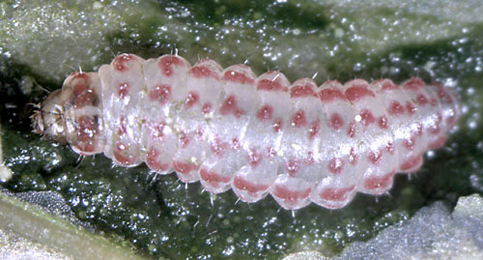|
||||||
|
Chrysoesthia
drurella (Fabricius, 1775) Flame Neb Tinea
drurella
Fabricius, 1775. Syst. ent.: 666. |
|||||||||||||||||||||||||||||||||||||||||||
|
Leaf-miner: The larvae feed by mining the leaves forming a contorted gallery (UKMoths). A strongly contorted, often intestinine-like corridor, often forming a secondary blotch. Much green frass in broad arcs. Full grown larva mostly on top of the midrib. Pupation external (Bladmineerders van Europa). The mine is also illustrated in British leafminers. Larva: The larvae of moths have a head capsule and chewing mouthparts with opposable mandibles (see video of a gracillarid larva feeding), six thoracic legs and abdominal legs (see examples). The red and white larva is illustrated in British leafminers, UKMoths and Bladmineerders van Europa.
Pupa: The pupae of moths have visible head appendages, wings and legs which lie in sheaths (see examples). On the ground in detritus (British leafminers). Adult: The adult is illustrated in UKMoths by Nigel Whinney. The species is included in mothdissection.co.uk. Hosts in Great Britain and Ireland:
Hosts elsewhere: Time of year - larvae: July - August, September (British leafminers). Time of year - adults: May and June, and again in August and September (UKMoths). Distribution in Great Britain and Ireland: Frequenting open ground and wasteland, and distributed widely throughout England (UKMoths) including Bedfordshire, Berkshire, Cambridgeshire, Denbighshire, East Norfolk, East Suffolk, Flintshire, Herefordshire, Hertfordshire, Huntingdonshire, Leicestershire, Middlesex, North Hampshire, Shropshire, Stafford, West Cornwall, West Norfolk and West Suffolk (NBN Atlas). Also recorded in the Channel Is. (Fauna Europaea). Rare in Scotland and not known in Ireland or Wales (UKMoths). See also British leafminers distribution map. Distribution elsewhere: Widespread in continental Europe including Albania, Austria, Belarus, Belgium, Bulgaria, Corsica, Czech Republic, Danish mainland, Estonia, Finland, French mainland, Germany, Greek mainland, Hungary, Italian mainland, Kaliningrad Region, Latvia, Lithuania, Luxembourg, Macedonia, Madeira, Norwegian mainland, Poland, Romania, Russia - Central, East, Northwest, South, Sicily, Slovakia, Spanish mainland, Sweden, Switzerland, The Netherlands and Ukraine (Fauna Europaea). NBN Atlas links to known host species: British and Irish Parasitoids in Britain and elsewhere:
|
| Last updated 14-Jul-2019 Brian Pitkin | ||

